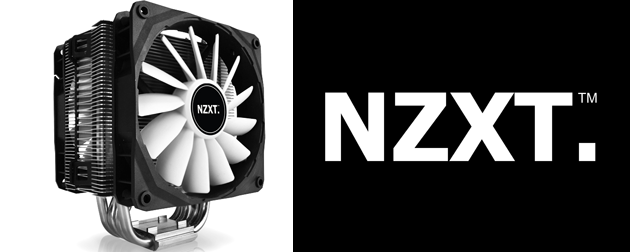Stock heatsinks—the ones that come with retail CPUs—are designed to do one thing, and nothing more—make sure the CPU doesn’t burn up. To be sure, they do the job well, but there are drawbacks. Moving your CPU beyond stock speeds is often difficult since those speeds might already be pushing the heatsink’s cooling capability to its limits. They’re often loud due to a small fan rotating at high speeds to draw heat away. Every one of these drawbacks is an argument for an aftermarket heatsink.
NZXT is one of the more recent entrants in the aftermarket heatsink arena. Its first offering, the Havik 140 is in testing right now, but today we present its little brother, the Havik 120.
The Havik 120 is similar to the previously released Havik 140, but differs in several key areas. First, it is both smaller and lighter. The Havik 140 weighs in at 1035 grams and measures 135 x 160 x 60 mm while the Havik 120 is about 5% lighter at 980 grams and about 11% smaller at 125 x 160 x 58 mm. Second, due to the smaller size only four heatpipes are present on the Havik 120 (the Havik 140 has six). Finally, the fans are smaller, have more fins, and can operate at two different speeds.
So, for $54.99, what do you get?
Specifications
- Dual 120mm, 13-blade fans
- Nickel-plated copper base
- Four 8mm pipes
- Variable fan speeds from 1200 to 1500RPM
- 18 – 22 dBA noise level
- 61.5 – 75.8 CFM airflow
- Universal bracket compatible with Intel and AMD sockets
- Rubber mounting for noise absorption
- Supports AMD sockets AM2, AM2+, AM3, and AM3+
- Supports Intel sockets 775, 1156, 1155, 1366, and 2011
There are two power cables for both fans to plug into: the white plug is for low speed, the black plug is for high speed. While this isn’t the most optimal solution for adjusting speed, it does work. On the plus side, a single motherboard fan header is used to power both fans.
Installing
Like most tower-style heatsinks, the Havik-120 uses a backplate that replaces the retention mechanism surrounding the socket (mostly the case for AMD sockets). That backplate is held onto the motherboard by the actual heatsink mount on the front of the motherboard. It’s similar to the system used by Noctua, but not quite as good. Why? Noctua heatsinks screw directly to the mount (making very secure and stable contact), the Havik 120 uses a crossbar that sits over the heatsink base and presses the heatsink onto the CPU. There are some small ridges on the crossbar to prevent the heatsink from sliding down, but those ridges don’t prevent a small amount of rotation about the center.
The fans are held to the heatsink by four rubber bands that attach through the mount holes in each fan. Those bands then loop through the fins on the heatsink. It works, but it’s a bit awkward to install since both fans have to be installed after the heatsink is in place. Since they’re rubber, there’s also a concern about the bands breaking from age or rubbing against the heatsink fins, though NZXT assures me that the bands will stand up to frequent movement. Should something happen to one, spare bands are included in the box.
Sound
The Havik 120 was tested in the Thermaltake Level 10 GT case with both side panels removed and positioned about three feet (from fan to ear). Even in this less-than-optimal condition, the Havik 120 does not disappoint. At high fan speeds the sound was noticeable, but it wasn’t particularly loud or annoying. It’s easily ignored and would certainly be drowned out by the sounds of gaming or media. Switch the power cables to low power and the Havik 120 becomes nearly silent.
Testing
At idle speeds, performance is fairly similar across all the heatsinks although the Havik on high speed does manage to slightly outperform the NH-D14. Of course, this all changes once the CPU has something to do. At that point, the Intel cooler is left in the dust. The NZXT Havik 120 with its low fan speed performs very well, holding the i7-2600K to a respectable 52C during both Metro 2033 and 3DMark 11 at 55C for video encoding.
 Surprisingly, the performance difference between high and low fan speeds is pretty small. The best a higher (and louder) Havik 120 fan speed could produce was during idle where a 2C improvement was achieved, while video encoding provided a 1C advantage. Gaming and 3DMark 11 produced identical results. Personally I’d rather take the extra couple degrees and run with the silent low speed.
Surprisingly, the performance difference between high and low fan speeds is pretty small. The best a higher (and louder) Havik 120 fan speed could produce was during idle where a 2C improvement was achieved, while video encoding provided a 1C advantage. Gaming and 3DMark 11 produced identical results. Personally I’d rather take the extra couple degrees and run with the silent low speed.
If you’re looking to upgrade from a stock Intel heatsink, the NZXT Havik 120 is a pretty good value. It puts in a solid performance—a vast improvement over stock parts, and doesn’t break the bank while doing so. The installation may be a touch awkward, but for most it’s a one-time event and quickly forgotten once things are up and running. We’re happy to award it the Icrontic Stamp of Approval.











 Articles RSS
Articles RSS